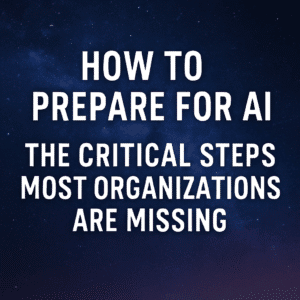Digital transformation is a complex and multifaceted process that requires more than just adopting new technologies. One of the most crucial prerequisites for a successful digital transformation is internal alignment. But what does internal alignment entail, and how can organizations achieve it? In this comprehensive guide, we’ll explore the concept of internal alignment in detail and provide actionable strategies to ensure your organization is aligned from top to bottom.
Table of Contents
ToggleUnderstanding Internal Alignment
Internal alignment refers to the process of ensuring that all components of an organization—strategy, executive team, project team, and frontline employees—are in sync and working towards the same goals. Without this alignment, even the most well-planned digital transformation initiatives can falter. Internal alignment helps organizations effectively leverage their resources, minimize conflicts, and maximize the value derived from their transformation efforts.
1. Strategic Alignment
Strategic alignment is the foundation of internal alignment. It involves ensuring that the digital transformation initiatives are in line with the organization’s overall business strategy. This includes:
- Defining Clear Goals and Objectives: Start by clearly articulating your organization’s vision, mission, and strategic objectives. This will serve as a roadmap for the transformation efforts and ensure that every initiative supports these overarching goals.
- Establishing Key Performance Indicators (KPIs): Identify measurable indicators that will help you track progress towards achieving your strategic objectives. These KPIs should be relevant to your business goals and provide insights into the effectiveness of your transformation efforts.
- Communicating the Strategy: Ensure that the strategic goals are communicated effectively across the organization. This involves sharing the vision, expected outcomes, and the role of digital transformation in achieving these goals with all stakeholders.
While many organizations have a clear strategic vision, the challenge often lies in translating this vision into actionable plans and ensuring alignment throughout the organization.
2. Executive Team Alignment
Having a well-defined strategy is only part of the equation. The executive team must also be aligned to effectively drive the digital transformation. Key aspects include:
- Unified Vision and Approach: Ensure that all executives share a common vision of the digital transformation and agree on the approach to achieve the strategic goals. This involves aligning on key decisions such as the level of standardization versus decentralization in business processes.
- Addressing Disagreements: Recognize that executives may have differing opinions on various aspects of the transformation. Address these disagreements through open dialogue and find a consensus that aligns with the overall strategy.
- Setting Clear Expectations: Clearly define the roles and responsibilities of each executive in the transformation process. This helps prevent conflicts and ensures that everyone is working towards the same objectives.
A lack of alignment at the executive level can lead to fragmented efforts and mixed messages, which can undermine the success of the transformation initiative.
3. Project Team Alignment
The project team is responsible for implementing the digital transformation on the ground. Ensuring alignment at this level involves:
- Integrating Strategy with Execution: The project team should have a clear understanding of the strategic goals and how their work supports these objectives. This involves translating high-level strategic goals into actionable tasks and decisions.
- Managing Conflicting Interests: Address potential conflicts between the executive team’s vision and the project team’s implementation. Ensure that the project team understands the importance of adhering to the strategic direction and avoid reverting to practices that may be easier but misaligned with the strategy.
- Regular Communication: Maintain regular communication between the executive team and the project team to ensure that any issues or misalignments are addressed promptly. This helps in keeping everyone on the same page and aligned towards common goals.
Effective project team alignment is crucial for translating strategic goals into successful outcomes and ensuring that the day-to-day management of the transformation aligns with the overall strategy.
4. Employee Frontline Alignment
The frontline employees are the ones who will ultimately use the new systems and processes. Their alignment is critical for the success of the digital transformation. Key strategies include:
- Involving Employees Early: Engage employees early in the transformation process. Solicit their feedback, involve them in planning, and ensure that they understand how the changes will impact their roles and the organization as a whole.
- Effective Change Management: Implement robust change management practices to help employees adapt to new technologies and processes. This includes providing training, addressing concerns, and supporting employees through the transition.
- Continuous Communication: Keep the lines of communication open with employees throughout the transformation. Regular updates and clear explanations of how their work supports the broader organizational goals can help in maintaining alignment and motivation.
Frontline alignment is essential for ensuring that new systems and processes are effectively adopted and that employees are engaged and committed to the transformation.
5. Measuring Business Value and ROI
Achieving alignment is not an end in itself; it must translate into tangible business value and return on investment (ROI). To ensure this, focus on:
- Continuous Measurement: Regularly measure the results of the transformation efforts against the established KPIs. This helps in assessing whether the transformation is delivering the expected value and identifies areas for improvement.
- Iterative Improvement: Use the insights gained from measuring results to make iterative improvements. This involves refining processes, addressing gaps, and optimizing systems to enhance the value derived from the transformation.
- Aligning Value with Strategy: Ensure that the business value delivered aligns with the strategic goals of the organization. This means making decisions based on how they will contribute to achieving the overall strategy and desired outcomes.
Measuring and optimizing business value is crucial for ensuring that the digital transformation delivers the intended benefits and supports the long-term success of the organization.
Strategies for Achieving Internal Alignment
To achieve and maintain internal alignment throughout your digital transformation, consider the following strategies:
- Prioritize Alignment Before Implementation: Don’t rush into technology implementation without first ensuring alignment across the organization. Take the time to address alignment issues upfront to set a solid foundation for the transformation.
- Invest in Change Management: Develop a comprehensive change management strategy to guide employees through the transformation. This includes clear communication, training, and support to facilitate smooth adoption and minimize resistance.
- Focus on Benefits Realization: Continuously track and measure the business value of the transformation. Use this information to make informed decisions and drive ongoing improvements to ensure that the transformation meets its objectives and delivers ROI.
- Involve Key Stakeholders: Engage key stakeholders, including executives, project team members, and frontline employees, in the transformation process. Their involvement and feedback are crucial for ensuring alignment and achieving successful outcomes.
By following these strategies, organizations can navigate the complexities of digital transformation and achieve internal alignment that drives success.
Conclusion
Internal alignment is a critical component of a successful digital transformation. By ensuring that your organization’s strategy, executive team, project team, and frontline employees are all working towards the same goals, you can enhance the effectiveness of your transformation efforts and maximize the value derived from your investments. Implementing the strategies outlined in this guide will help you achieve and maintain alignment, leading to a more successful and impactful digital transformation.
For further insights on managing change, stakeholder engagement, and achieving alignment in digital transformation, download our comprehensive guide on change management. It offers practical tips and best practices to support your organization through its transformation journey.

How Can We Help with your Business Transformation
At Third Stage Consulting, we are passionate about empowering organizations to successfully navigate the complexities of digital transformation. Whether you’re embarking on a new transformation journey or aiming to optimize your current processes, our expert team is committed to providing comprehensive support throughout every phase. From initial strategy development to execution and beyond, we work closely with you to ensure that your transformation goals are met efficiently and effectively.





